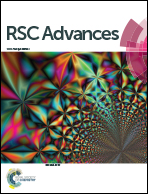The hydrogen sensing properties of Pt–Pd/reduced graphene oxide based sensor under different operating conditions
Abstract
Graphene is a two-dimensional nanomaterial with high specific surface area, excellent physical and chemical properties with great potential in sensor applications. Uniform nanocrystalline Pt–Pd nanoparticle-decorated reduced graphene oxide (Pt–Pd/RGO) has been synthesized via a one-step chemical reduction. Dielectrophoresis applied to Pt–Pd/RGO fabricated the sensor. The hydrogen sensing properties of Pt–Pd/RGO were studied by recording the resistance changes following exposure to hydrogen at different concentrations, temperatures, flow rate and with different carrier gases. The Pt–Pd/RGO sensor has a stable and repeatable response due to carrier donation and crystal lattice expansion over hydrogenation and dehydrogenation. The maximum response tends to increase with the increase of hydrogen concentration or decrease of operating temperature, but remained almost unaffected by the flow rate. The nitrogen as carrier gas possesses higher response and longer recovery time than air because oxygen participates in the reaction. These studies have potential for the development of novel H2 sensors.


 Please wait while we load your content...
Please wait while we load your content...